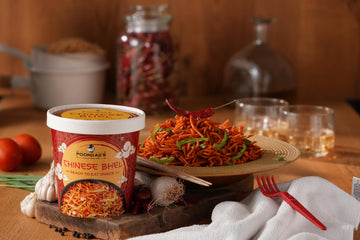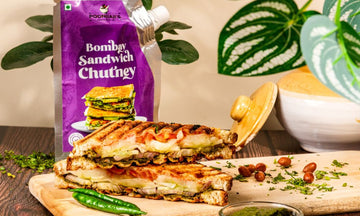Chinese Bhel
Chinese bhel is a common Indo-Chinese Street food snack!
A perfect combination of Chinese and Indian culinary components, this dish is peppered with cottage cheese and shredded chicken, both of which would then be combined with chopped vegetables, including onions, bell peppers, cabbage, and carrots.
This tantalising fried noodles dish is prepared by combining the above elements and then adding chilli sauce, soy sauce, and occasionally some lime juice or a tart tamarind sauce. Topped with cilantro and green onions, and sometimes fried garlic and peanuts, the final product results in a gorgeously sour and sweet snack savoured by Asians everywhere!
Fried Noodles to Chinese Bhel? How??
The fried noodles are first cooked till golden brown and crispy, and then they are placed aside to cool to make Chinese Bhel.
In the meantime, the veggies are prepared for mixing with the noodles by being cleaned, peeled, and sliced into bite-sized pieces. After the noodles cool, they're combined with the chopped veggies and the appropriate quantity of seasonings and sauces in a big mixing bowl.
Every bite is guaranteed to be exploding with flavour and texture after everything is uniformly coated.
What exactly are fried noodles?
Fried noodles are fried versions of ... well ... noodles!!
But there's a little bit to learn about noodles as well ...
Noodles have a history tracing back to the Han dynasty in Ancient China, boasting over 4,000 years of culinary tradition. Various narratives surround the origins of noodles, each weaving a tale that reflects the cultural ethos and societal norms of China. Essentially synonymous with "human nature" and "worldly wisdom," noodles serve as a culinary emblem embodying the essence of Chinese culture and tradition.
But noodles have long since left China and spread across the globe, from Singapore to Thailand to, well, India!
They are frequently used as a foundation or garnish for salads, soups, and stir-fries, and they give food a crunchy texture once fried. Fried noodles come in many forms, each with a distinct flavour profile and cooking technique specific to that location.
Crispy fried noodles, for instance, are frequently used as a foundation for recipes like Chow Mein or as a crunchy side dish for soups in Chinese cuisine. In Thai cuisine, fried noodles are often used in dishes, such as in Pad Thai or as a salad garnish. In the case of Chinese bhel, fried noodles are one of the key ingredients that provide crunchiness to the dish.

What are fried noodles made of?
Fried noodles can be made of a variety of ingredients, like classic all-purpose flour, or healthier versions like egg, rice, wheat, and even instant noodles. Each type of noodle has a distinct texture and flavour profile, which might influence the dish's final flavour.
Fried noodles for Chinese bhel are typically made with tapioca flour or Maida (all-purpose flour) noodles.
Where did it all start?
After the Indo-China war, India saw an introduction of Chinese cuisine in restaurants and other eateries. Slowly the natives started to introduce "Chinese" flavours by adding soy and vinegar sauces in the Indian or "desi" food, to adapt to the palates of the average Indian consumer.
The bhel traditionally is an Indian dish made up of puffed rice, Channa, and sev, which is mixed with spicy and tangy Indian chutneys. To give the dish a Chinese twist. and making it a part of the Indo-Chinese cuisine, fried noodles and a mixture of Indian and Chinese sauces are used.
Chinese Bhel finds its roots in India, particularly in the state of Maharashtra. This fusion dish harmonises elements of both Indian and Chinese culinary traditions. While the precise origins of Chinese Bhel remain elusive, it has emerged as a popular street food option all over India.
The meal became popular because of its distinct combination of crispy fried noodles, fresh veggies, and rich sauces, which appealed to Indian consumers' varied taste preferences.
Over time, Chinese bhel has become a popular snack in India, it can be found everywhere!! Whether it's the historic streets of Colaba or the narrow lanes of Dharavi, you can catch street sellers joyously tossing strands of cooked fried noodles into the pan with a variety of cut veg and meat, proudly serving this concoction in paper plates and even newspapers to their loyal patrons that watch with hungry eyes.
It is now less a food dish and more a part of India's street culture.
Chinese Bhel has a unique role in Indian culture, bridging the gap between two diverse culinary traditions. It represents the ever-evolving character of Indian society, where cultural influences from across the globe are embraced and customized to suit local palates and preferences.
While Chinese Bhel is strongly entrenched in Indian culinary history, it has achieved global recognition and rapidly gained popularity.
Indian restaurants and food trucks in the United States, United Kingdom, Canada, and Australia frequently put Chinese Bhel on their menus to appeal to their clients' different tastes. Its blend of Indian and Chinese spices makes it a universally appetizing dish that crosses ethnic borders and pleases foodies of all origins.
Food is something that holds the power to bring people together irrespective of the factors dividing them, and Chinese bhel does that.

Chinese bhels near me - Where to find your next perfect mouthwatering plate
Chinese Bhel has become a popular item on the menus of many Indian restaurants, particularly those specializing in Indo-Chinese cuisine. These restaurants often offer a wide range of Chinese-inspired dishes, from classic favourites like fried rice and noodles to innovative creations like Manchurian gravy and chilli paneer. Chinese Bhel is typically served as a snack or as a standalone dish. However, served, people always love it!
While Chinese Bhel is widely accessible at street food carts and eateries, many people prefer to prepare it at home. The dish is relatively simple and only takes a few ingredients, making it suitable for amateur chefs.
Individuals who prepare Chinese Bhel at home can control the quality of the ingredients and can modify the flavours to their liking. Furthermore, the act of creating and enjoying Chinese Bhel with friends and family can be a comforting experience.

How To Make Our LEGENDARY Chinese Bhel
- Empty the fried noodles in the disposable cup
- Pour the Chinese bhel chutney sachet into the cup as well. The crowning glory of a good Chinese bhel is the sauces that go in it. Our chutney is a secret sauce that we have curated specially for this bhel and we can assure excellence with each bite.
- Close the lid and mix it thoroughly for 1-2 mins or until the chutney coats all over the food or noodles.
- Remove the lid and the Chinese Bhel will be ready.
Here are some of the best outlets for you to try out, the next time that you crave some Chinese bhel:

Poonjiaji’s legacy dates back to the days of the British Raj, in 1883. Having a penchant for all things spicy and aromatic, Poonjiaji got appointed by the governor of Bombay, as their official supplier. The wheels turned, and a gastronomic journey began taking Poonjiaji into the realms of various spices and condiments, tastes and colours never explored before. Gathering this vast knowledge and having a unique understanding of various spices & spices blends, Poonjiaji took over into a warm, aromatic and soothing blanket of spices. M.M Poonjiaji Spices Limited from the beginning left its mark on the Indian spice industry, taking it to new levels by creating an exquisite range of Chutney, Pickles, Condiments, Pastes and Spices and sharing it with the world to meet the needs of global palettes.
Elco Pani Puri Centre - Bandra
The small cart, which is now the ELCO Pani Puri Centre, was started by Mr. Mohandas Bhagnani in 1947. Over the last five decades, the ELCO Pani Puri Centre has undergone enormous transformations. But one thing has stayed the same throughout - its authentic taste. To make sure that it serves the same old taste to its customers, the Paani Puri Centre buys the raw materials from the same suppliers, who were appointed back then!
Hitchki, BKC
The internationally aspiring brand focuses on regional & eclectic cuisine and introduces elements of the years gone by to the “Hitchki” experience. Each dish has a quirky touch in a way that suits the palate and lifestyle of the current day, by way of contemporary preparation and plating, without compromising on the traditional Flavors across India.
Shiv Sagar, Kemps Corner
Mr. Shankar Poojari started Shiv Sagar in 1978 as a juice house. Shankar felt energised by Bombay’s rich and diverse food, culture, theatre, art, and music. The people of Bombay became a part of his family.
Butterfly High, BKC
Butterfly High emerges as an oasis of indulgence in the vibrant heart of Mumbai, blending a symphony of flavours, pulsating beats and a touch of star-studded allure. Situated strategically in Mumbai’s bustling corporate and residential hubs, Butterfly High holds a coveted position as one of the city’s hotspots. Your cosmopolitan modern, fusion, and progressive Indian culinary experience is brought to life with eclectic and Instagram-worthy interiors.
Bombay Cartel, Kamala Mills Compound
Established in the year 2017, The Bombay Cartel in Lower Parel, Mumbai is a top player in the category of North Indian Restaurants in Mumbai. This well-known establishment acts as a one-stop destination servicing customers both locally and from other parts of Mumbai.
Socials, Colaba
Socials first opened in 2014 in the heart of Bengaluru-church Street. Since then, the establishments have rapidly grown and has 33 branches all over India. The chain was founded by Riyaz Amlani, CEO and Managing Director of Impresario Handmade Restaurants. The initial plan was for Social to be a cafe and a coworking space. However, it didn’t take long for the place to become a hotspot that also shone across the city during the night - turning itself into a pub.

Chinese Bhel is more than just a delicious dish; it represents the creativity and culinary innovation of the creators—this fusion dish, which originated on the streets of Maharashtra and is now relished throughout India.
It demonstrates the Indian cuisine's diversity. The delightful fusion of Flavors and textures in Chinese Bhel continues to captivate the palates of countless individuals, showcasing food's ability to unite people and honour cultural diversity.
In the fast-paced lives of people where everything is constantly changing, Chinese bhel has managed to remain a constant comfort for the people.


